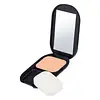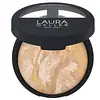Max Factor X Facefinity Compact Foundation Versus Laura Geller Baked Balance-N-Brighten Color Correcting Foundation
What's inside
What's inside
 Key Ingredients
Key Ingredients

 Benefits
Benefits

 Concerns
Concerns

 Ingredients Side-by-side
Ingredients Side-by-side

Mica
Cosmetic ColorantTalc
AbrasiveDimethicone
EmollientEthylhexyl Methoxycinnamate
UV AbsorberSilica
AbrasiveTrimethylsiloxysilicate
EmollientNylon-12
Methicone
EmollientCholesteryl Stearate
EmollientTocopherol
AntioxidantBHT
AntioxidantDiethylhexyl Succinate
EmollientEthylhexyl Hydroxystearate
EmollientHydrogen Dimethicone
Methylparaben
PreservativePropylparaben
PreservativeSodium Dehydroacetate
PreservativeCI 77891
Cosmetic ColorantCI 77492
Cosmetic ColorantCI 77491
Cosmetic ColorantCI 77499
Cosmetic ColorantMica, Talc, Dimethicone, Ethylhexyl Methoxycinnamate, Silica, Trimethylsiloxysilicate, Nylon-12, Methicone, Cholesteryl Stearate, Tocopherol, BHT, Diethylhexyl Succinate, Ethylhexyl Hydroxystearate, Hydrogen Dimethicone, Methylparaben, Propylparaben, Sodium Dehydroacetate, CI 77891, CI 77492, CI 77491, CI 77499
Mica
Cosmetic ColorantTalc
AbrasiveDimethicone
EmollientIsopropyl Palmitate
EmollientPolysorbate 20
EmulsifyingMagnesium Aluminum Silicate
AbsorbentTocopherol
AntioxidantCentella Asiatica Extract
CleansingCamellia Sinensis Leaf Extract
AntimicrobialSimmondsia Chinensis Seed Oil
EmollientEthylhexyl Methoxycinnamate
UV AbsorberTocopheryl Acetate
AntioxidantRetinyl Palmitate
Skin ConditioningPropylene Glycol Dicaprylate/Dicaprate
EmollientLauroyl Lysine
Skin ConditioningSodium Dehydroacetate
PreservativePhenoxyethanol
PreservativeBHT
AntioxidantNylon-12
Tin Oxide
AbrasiveCI 77891
Cosmetic ColorantIron Oxides
CI 77288
Cosmetic ColorantCI 77742
Cosmetic ColorantMica, Talc, Dimethicone, Isopropyl Palmitate, Polysorbate 20, Magnesium Aluminum Silicate, Tocopherol, Centella Asiatica Extract, Camellia Sinensis Leaf Extract, Simmondsia Chinensis Seed Oil, Ethylhexyl Methoxycinnamate, Tocopheryl Acetate, Retinyl Palmitate, Propylene Glycol Dicaprylate/Dicaprate, Lauroyl Lysine, Sodium Dehydroacetate, Phenoxyethanol, BHT, Nylon-12, Tin Oxide, CI 77891, Iron Oxides, CI 77288, CI 77742
 Reviews
Reviews

Ingredients Explained
These ingredients are found in both products.
Ingredients higher up in an ingredient list are typically present in a larger amount.
BHT is a synthetic antioxidant and preservative.
As an antioxidant, it helps your body fight off free-radicals. Free-radicals are molecules that may damage your skin cells.
As a preservative, it is used to stabilize products and prevent them from degrading. Specifically, BHT prevents degradation from oxidation.
The concerns related to BHT come from oral studies; this ingredient is currently allowed for use by both the FDA and EU.
However, it was recently restricted for use in the UK as of April 2024.
Learn more about BHTCi 77891 is a white pigment from Titanium dioxide. It is naturally found in minerals such as rutile and ilmenite.
It's main function is to add a white color to cosmetics. It can also be mixed with other colors to create different shades.
Ci 77891 is commonly found in sunscreens due to its ability to block UV rays.
Learn more about CI 77891Dimethicone is a type of synthetic silicone created from natural materials such as quartz.
What it does:
Dimethicone comes in different viscosities:
Depending on the viscosity, dimethicone has different properties.
Ingredients lists don't always show which type is used, so we recommend reaching out to the brand if you have questions about the viscosity.
This ingredient is unlikely to cause irritation because it does not get absorbed into skin. However, people with silicone allergies should be careful about using this ingredient.
Note: Dimethicone may contribute to pilling. This is because it is not oil or water soluble, so pilling may occur when layered with products. When mixed with heavy oils in a formula, the outcome is also quite greasy.
Learn more about DimethiconeEthylhexyl Methoxycinnamate is an organic compound that provides UVB protection. It often goes by the more common name of octinoxate. It is created from methoxycinnamic acid and 2-ethylhexanol.
Ethylhexyl Methoxycinnamate absorbs UVB rays with wavelengths between 280-320 nm. UV absorbers protect your skin by using chemical reactions to convert UV rays into heat and energy.
UVB (290-320 nm) rays emit more energy than UVA rays. They are capable of damaging DNA, causing sunburns and are thought to be linked to skin cancer.
The state of Hawaii has banned sunscreens containing octinoxate due to its potential impact on coral reefs. More research is needed to bridge gaps in this research. The European Union allows higher levels of octinoxate in sunscreens than the US and Australia.
Ethylhexyl Methoxycinnamate is oil soluble. It is not stable and may lose efficacy when exposed to sunlight.
Learn more about Ethylhexyl MethoxycinnamateMica is a naturally occurring mineral used to add shimmer and color in cosmetics. It can also help improve the texture of a product or give it an opaque, white/silver color.
Serecite is the name for very fine but ragged grains of mica.
This ingredient is often coated with metal oxides like titanium dioxide. Trace amounts of heavy metals may be found in mica, but these metals are not harmful in our personal products.
Mica has been used since prehistoric times throughout the world. Ancient Egyptian, Indian, Greek, Roman, Aztec, and Chinese civilizations have used mica.
Learn more about MicaNylon-12 is a polymer. It is derived from 12-aminododecanoic acid, an omega-amino fatty acid
According to a manufacturer, it is a talc substitute. Like talc, nylon-12 gives products a satin feel. The manufacturer also claims this ingredients does not block pores and has moderate oil absorption.
This ingredient may not be reef-safe.
Learn more about Nylon-12This ingredient is a preservative with antimicrobial properties. It is the sodium salt of dehydroacetic acid.
It is especially effective at preventing bacterial and fungal growth in low concentrations.
Talc is a clay mineral. It helps absorb moisture and improve the texture of products. Like other types of clay, Talc can have a slight exfoliating effect on skin. Talc can be added to increase the volume of products.
Some Baby powders are made by combining talc with corn starch. The word "talc" comes from Latin and originates from Arabic. Talc is a mineral commonly found throughout the world.
If you have any concerns about using talc, we recommend checking out the FDA's official page.
Learn more about TalcTocopherol (also known as Vitamin E) is a common antioxidant used to help protect the skin from free-radicals and strengthen the skin barrier. It's also fat soluble - this means our skin is great at absorbing it.
Vitamin E also helps keep your natural skin lipids healthy. Your lipid skin barrier naturally consists of lipids, ceramides, and fatty acids. Vitamin E offers extra protection for your skin’s lipid barrier, keeping your skin healthy and nourished.
Another benefit is a bit of UV protection. Vitamin E helps reduce the damage caused by UVB rays. (It should not replace your sunscreen). Combining it with Vitamin C can decrease sunburned cells and hyperpigmentation after UV exposure.
You might have noticed Vitamin E + C often paired together. This is because it is great at stabilizing Vitamin C. Using the two together helps increase the effectiveness of both ingredients.
There are often claims that Vitamin E can reduce/prevent scarring, but these claims haven't been confirmed by scientific research.
Learn more about Tocopherol